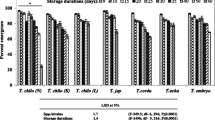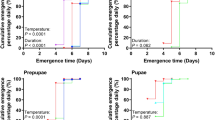Abstract
Efficient storage of the biological controlagent Trichogramma ostriniae couldimprove current parasitoid production methodsby making the system more flexible andefficient. Initial studies compared emergencerates of T. ostriniae reared onSitotroga cerealella eggs held at 6 °C, 9 °C, 12 °C,15 °C, and 24 °C for up to 8 weeks after parasitism.At 15 °C, emergence occurred in <2 weeks.Emeregence was >80% for parasitized eggsstored at 9 °C and 12 °C for 4 and 6 weeksrespectively. Storage at 6 °C caused asignificant decline in emergence after 2 weeks. Subsequent trials focused on fitness of storedT. ostriniae. Percentage of emergedfemales parasitizing eggs, female longevity,and fecundity were quantified after storage.The percentage of females successfullyparasitizing O. nubilalis eggs wasgreatest for the 9 °C four-week treatment(100%). Compared to 24 °C controls, storage at12 °C for 6 weeks or at 9 °C for 8 weeks reduced thepercentage of females parasitizing. Longevityof females held in cold storage was generallyless than that of controls. Rates of parasitismby stored Trichogramma was generallysimilar to controls after 2 to 4 weeks' storageat 9 °C and 12 °C but declined with storage longerthan 4 weeks. Emergence of progeny of cold-storedfemales was lower than controls for alltreatments. The percentage of female progenyfrom cold stored females was comparable tocontrols up to 4 weeks of storage.
Similar content being viewed by others
References
Bigler, F., 1994. Quality control in Trichogramma production. In: E. Wajnberg and S.A. Hassan (eds), Biological Control with Egg Parasitoids. Oxon, CAB International, UK. pp. 93–111.
Bonnemaison, L., 1972. Diapause et superparasitisme chez Trichogramma evanescens Westwood. B. Soc. Entomol. Fr. 5: 123–132.
Carrière, Y. and G. Boivin, 2001. Constraints on the evolution of thermal sensitivity of foraging in Trichogramma: Genetic trade-offs and plasticity in maternal selection. Am. Nat. 157: 570–581.
Glenister, C.S. and M.P. Hoffmann, 1998. Mass-reared natural enemies: scientific, technological, and informational needs and considerations. In: R.L. Ridgway, M.P. Hoffmann, M.N. Inscoe and C.S. Glenister (eds), Mass Reared Natural Enemies: Application, Regulation, and Needs. Proceedings: Thomas Say Publications in Entomology, Entomological Society of America. Lanham, MD. pp. 242–267.
Gou, X.Q., 1985. Cold storage test of rice moth eggs parasitized by Trichogramma ostriniae. Chinese J. Biol. Control 1: 20–21.
Hoffmann, M.P., D.L. Walker and A.M. Shelton, 1995. Biology of Trichogramma ostriniae (Hymenoptera: Trichogrammatidae) reared on Ostrinia nubilalis (Lepidoptera: Pyralidae) and survey for additional hosts. Entomophaga 40: 387–402.
Hoffmann, M.P., A. Seaman, J. Gardner and S.A. Chenus, 1997. Early season establishment of Trichogramma ostriniae for season-long suppression of European corn borer in sweet corn. In: New York State Vegetable Project Reports Relating to IPM. NYS IPM Publication #123. Cornell Cooperative Extension. pp. 143–147.
Iacob, M. and N. Iacob, 1972. Influence of temperature variations on the resistance of the wasp Trichogramma evanescens Westwood to storage with a view to field releases. Inst. Cerce. Prot. Plant. 8: 191–199.
Jalali, S.K. and S.P. Singh, 1992. Differential response of four Trichogramma species to low temperatures for short term storage. Entomophaga 37: 159–165.
Knutson, A., 1998. The Trichogramma Manual, A guide to the use of Trichogramma for biological control with special reference to augmentative releases for control of bollworm and budworm in cotton. Texas Agricultural Extension Service. B-6071, pp. 5–98.
Laing, J.E. and J.E. Corrigan, 1995. Diapause induction and post-diapause emergence in Trichogramma minutum Riley (Hymenoptera: Trichogrammatidae): the role of host species, temperature, and photoperiod. Can. Entomol. 127: 103–110.
Mason, C.E., M.E. Rice, D.D. Calvin, J.W. Van Duyn, W.B. Showers, W.D. Hutchison, J.F. Witkowski, R.A. Higgins, D.W. Onstad and G.P. Dively, 1996. European Corn Borer Ecology and Management. North Central Regional Extension Publication No. 327, Iowa State University, Ames, Iowa. pp. 1–55.
Metcalf, R.L. and R.A. Metcalf, 1993. Destructive and Useful Insects, Their Habits and Control, 5th edn. McGraw-Hill. pp. 9. 25–9. 31.
Qian, Y.Q., R.L. Cao and G.Z. Li, 1984. Biology of Trichogramma ostriniae and evaluations of its effectiveness in controlling corn borer on spring corn. Acta Entomol. Sinica 27: 287–293.
Seaman, A., M.P. Hoffmann, J. Gardner and S. A. Chenus, 1996. Pilot testing of Trichogramma ostriniae releases in fresh market sweet corn for control of European corn borer. In: New York State Vegetable Project Reports Relating to IPM. NYS IPM Publication #122. Cornell Cooperative Extension.
Showers, W.B., J.F. Witkowski, C.E. Mason, D.D. Calvin, R.A. Higgins and G.P. Dively, 1989. European Corn Borer Development and Management. North Central Regional Extension Publication No. 327, Iowa State University, Iowa.
Smith, S.M., 1996. Biological control with Trichogramma: advances, successes and potential of their use. Annu. Rev. Entomol. 41: 375–406.
Straub, R.W. and B. Emmett. 1992. Pests of monocotyledon crops. In: R.G. McKinley (ed), Vegetable Crop Pests. CRC Press, Boca Raton. pp. 229–235.
van Lenteren, J.C., 1986. Evaluation, mass production, quality control and release of entomophagous insects. In: J.M. Franz (ed), Biological Plant and Health Protection: Biological Control of Plant Pests and Vectors of Human and Animal Diseases. Proceedings, International Symposium of the Akademie der Wissenschaffen und der Literatur, 15–17 November 1984, Mainz, Germany. Gustav Fischer, Stuttgart, Germany. pp. 31–56.
Wang, B., D.N. Ferro and D.W. Hosmer, 1999. Effectiveness of Trichogramma ostriniae and T. nubilale for controlling the European corn borer Ostrinia nubilalis in sweet corn. Entomol. Exp. App. 91: 297–303.
Wright, M.G., M.P. Hoffmann, S.A. Chenus and J. Gardner, 2001. Dispersal behaviour of Trichogramma ostriniae (Hymenoptera: Trichogrammatidae) in sweet corn fields: Implications for augmentative releases against Ostrinia nubilalis (Lepidoptera: Crambidae). Biol. Control 22: 29–37.
Zhu, D.F. and Y.H. Shang, 1987. Cold storage tolerance of Trichogramma developed from fluctuating temperatures. Nat. Enem. Insects 9: 111–114.
Author information
Authors and Affiliations
Corresponding author
Rights and permissions
About this article
Cite this article
Pitcher, S.A., Hoffmann, M.P., Gardner, J. et al. Cold storage of Trichogramma ostriniae reared on Sitotroga cerealella eggs. BioControl 47, 525–535 (2002). https://doi.org/10.1023/A:1016533116798
Issue Date:
DOI: https://doi.org/10.1023/A:1016533116798




